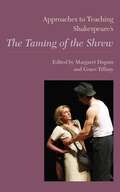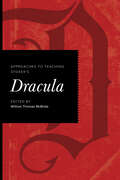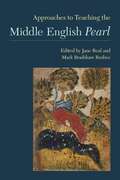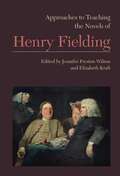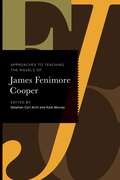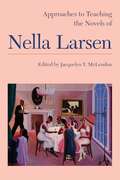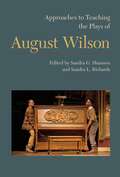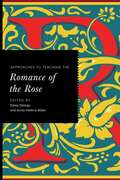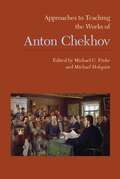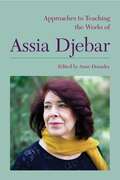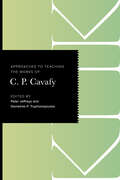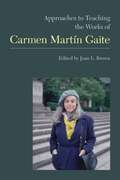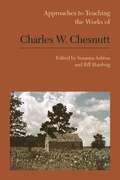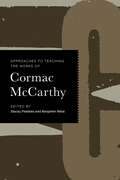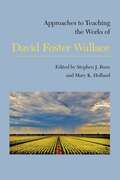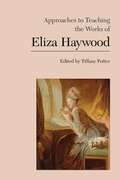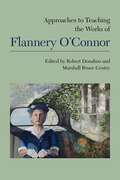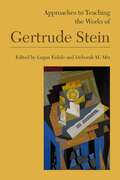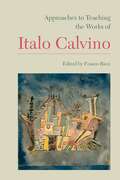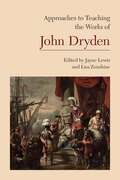- Table View
- List View
Approaches to Teaching Shakespeare's The Taming of the Shrew (Approaches to Teaching World Literature #123)
by Margaret Dupuis and Grace TiffanyThe impetus for this Approaches to Teaching volume on The Taming of the Shrew grew from the editors' desire to discover why a play notorious for its controversial exploration of conflicts between men and women and the challenges of marriage is enduringly popular in the classroom, in the performing arts, and in scholarship. The result is a volume that offers practical advice to teachers on editions and teaching resources in part 1, "Materials," while illuminating how the play's subtle and complex arguments regarding not just marriage but a host of other subjects--modes of early modern education, the uses of clever rhetoric, intergenerational and class politics, the power of theater--are being brought to life in college classrooms. The essays in part 2, "Approaches," are written by English and theater instructors who have taught in a variety of academic settings and cover topics including early modern homilies and music, Hollywood versions of The Taming of the Shrew, and student performances.
Approaches to Teaching Stoker's Dracula
by William Thomas McBrideThis volume helps teachers contextualize Bram Stoker's Dracula in its historical and cultural moment, considering psychology, technology, gender roles, colonialism, and anxieties about the other. It also situates the novel among the kindred texts that have proliferated since its publication, from film and television to the growing genre of vampire novels.Essays explore the novel in terms of medical humanities, contagion, and the gothic as well as ethnicity, identity, and race. Contributors analyze Dracula in the context of various ancient and modern cultural productions, including classical Indian aesthetics and African American vampire literature, and describe a broad range of classroom settings, including a technical university, a Hispanic-serving institution, and others.
Approaches to Teaching the Middle English Pearl (Approaches to Teaching World Literature #143)
by Jane Beal and Mark Bradshaw BusbeeThe moving, richly allegorical poem Pearl was likely written by the anonymous poet who also penned Sir Gawain and the Green Knight. In it, a man in a garden, grieving the loss of a beloved pearl, dreams of the Pearl-Maiden, who appears across a stream. She teaches him the nature of innocence, God's grace, meekness, and purity. Though granted a vision of the New Jerusalem by the Pearl-Maiden, the dreamer is pained to discover that he cannot cross the stream himself and join her in bliss--at least not yet. This extraordinary poem is a door into late medieval poetics and Catholic piety.Part 1 of this volume, "Materials," introduces instructors to the many resources available for teaching the canonical yet challenging Pearl, including editions, translations, and scholarship on the poem as well as its historical context. The essays in part 2, "Approaches," offer instructors tools for introducing students to critical issues associated with the poem, such as its authorship, sources and analogues, structure and language, and relation to other works of its time. Contributors draw on interdisciplinary approaches to outline ways of teaching Pearl in a variety of classroom contexts.
Approaches to Teaching the Novels of Henry Fielding (Approaches to Teaching World Literature #139)
by Jennifer Preston Wilson and Elizabeth KraftThe works of Henry Fielding, though written nearly three hundred years ago, retain their sense of comedy and innovation in the face of tradition, and they easily engage the twenty-first-century student with many aspects of eighteenth-century life: travel, inns, masquerades, political and religious factions, the '45, prisons and the legal system, gender ideals and realities, social class.Part 1 of this volume, "Materials," discusses the available editions of Joseph Andrews, Tom Jones, Shamela, Jonathan Wild, and Amelia; suggests useful critical and contextual works for teaching them; and recommends helpful audiovisual and electronic resources. The essays of part 2, "Approaches," demonstrate that many of the methods and models used for one novel-- the romance tradition, Fielding's legal and journalistic writing, his techniques as a playwright, the ideas of Machiavelli-- can be adapted to others.
Approaches to Teaching the Novels of James Fenimore Cooper (Approaches to Teaching World Literature #172)
by Deepika Bahri Filippo MenozziA cosmopolitan author who spent nearly a decade in Europe and was versed in the works of his British and French contemporaries, James Fenimore Cooper was also deeply concerned with the America of his day and its history. His works embrace themes that have dominated American literature since: the frontier; the oppression of Native Americans by Europeans; questions of race, gender, and class; and rugged individualism, as represented by figures like the pirate, the spy, the hunter, and the settler. His most memorable character, Natty Bumppo, has entered into American popular culture.The essays in this volume offer students bridges to Cooper's novels, which grapple with complex moral issues that are still crucial today. Engaging with film adaptations, cross-culturalism, animal studies, media history, environmentalism, and Indigenous American poetics, the essays offer new ways to bring these novels to life in the classroom.
Approaches to Teaching the Novels of Nella Larsen (Approaches to Teaching World Literature #138)
by Jacquelyn Y. McLendonNella Larsen's novels Quicksand and Passing, published at the height of the Harlem Renaissance, fell out of print and were thus little known for many years. Now widely available and taught, Quicksand and Passing challenge conventional "tragic mulatta" and "passing" narratives. In part 1, "Materials," of Approaches to Teaching the Novels of Nella Larsen, the editor surveys the canon of Larsen's writing, evaluates editions of her works, recommends secondary readings, and compiles a list of useful multimedia resources for teaching.The essays in part 2, "Approaches," aim to help students better understand attitudes toward women and race during the Harlem Renaissance, the novels' relations to other artistic movements, and legal debates over racial identities in the early twentieth century. In so doing, contributors demonstrate how new and seasoned instructors alike might use Larsen's novels to explore a wide range of topics--including Larsen's short stories and letters, the relation between her writings and her biography, and the novels' discussion of gender and sexuality.
Approaches to Teaching the Plays of August Wilson (Approaches to Teaching World Literature #140)
by Sandra G. Shannon and Sandra L. RichardsThe award-winning playwright August Wilson used drama as a medium to write a history of twentieth-century America through the perspectives of its black citizenry. In the plays of his Pittsburgh Cycle, including the Pulitzer Prize-winning Fences and The Piano Lesson, Wilson mixes African spirituality with the realism of the American theater and puts African American storytelling and performance practices in dialogue with canonical writers like Aristotle and Shakespeare. As they portray black Americans living through migration, industrialization, and war, Wilson's plays explore the relation between a unified black consciousness and America's collective identity.In part 1 of this volume, "Materials," the editors survey sources on Wilson's biography, teachable texts of Wilson's plays, useful secondary readings, and compelling audiovisual and Web resources. The essays in part 2, "Approaches," look at a diverse set of issues in Wilson's work, including the importance of blues and jazz, intertextual connections to other playwrights, race in performance, Yoruban spirituality, and the role of women in the plays.
Approaches to Teaching the Romance of the Rose (Approaches to Teaching World Literature #170)
by Daisy Delogu and Anne-Hélène MillerOne of the most influential texts of its time, the Romance of the Rose offers readers a window into the world view of the late Middle Ages in Europe, including notions of moral philosophy and courtly love. Yet the Rose also explores topics that remain relevant to readers today, such as gender, desire, and the power of speech. Students, however, can find the work challenging because of its dual authorship by Guillaume de Lorris and Jean de Meun, its structure as an allegorical dream vision, and its encyclopedic length and scope. The essays in this volume offer strategies for teaching the poem with confidence and enjoyment. Part 1, "Materials," suggests helpful background resources. Part 2, "Approaches," presents contexts, critical approaches, and strategies for teaching the work and its classical and medieval sources, illustrations, and adaptations as well as the intellectual debates that surrounded it.
Approaches to Teaching the Works of Amitav Ghosh (Approaches to Teaching World Literature #157)
by Gaurav Desai and John HawleyThe prizewinning author of novels, nonfiction, and hybrid texts, Amitav Ghosh grew up in India and trained as an anthropologist. His works have been translated into over thirty languages. They cross and mix a number of genres, from science fiction to the historical novel, incorporating ethnohistory and travelogue and even recuperating dead languages. His subjects include climate change, postcolonial identities, translocation, migration, oceanic spaces, and the human interface with the environment.Part 1 of this volume discusses editions of Ghosh's works and the scholarship on Ghosh. The essays in part 2, "Approaches," present ideas for teaching his works through considerations of postcolonial feminism, historicity in the novels, environmentalism, language, sociopolitical conflict, genre, intersectional reading, and the ethics of colonized subjecthood. Guidance for teaching Ghosh in different contexts, such as general education, world literature, or single-author classes, is provided.
Approaches to Teaching the Works of Anton Chekhov (Approaches to Teaching World Literature #141)
by Michael C. Finke and Michael HolquistChekhov's works are unflinching in the face of human frailty. With their emphasis on the dignity and value of individuals during unique moments, they help us better understand how to exist with others when we are fundamentally alone. Written in Russia at the end of the nineteenth century, when the country began to move fitfully toward industrialization and grappled with the influence of Western liberalism even as it remained an autocracy, Chekhov's plays and stories continue to influence contemporary writers.The essays in this volume provide classroom strategies for teaching Chekhov's stories and plays, discuss how his medical training and practice related to his literary work, and compare Chekhov with writers both Russian and American. The volume also aims to help instructors with the daunting array of new editions in English, as well as with the ever-growing list of titles in visual media: filmed theater productions of his plays, adaptations of the plays and stories scripted for film, and amateur performances freely available online.
Approaches to Teaching the Works of Assia Djebar (Approaches to Teaching World Literature #144)
by Anne DonadeyA significant and prolific francophone writer and filmmaker, Assia Djebar is celebrated for her experimental, multilingual prose and her nuanced, imaginative representations of Algeria. From her first novel, La soif (The Mischief), to her final book, Nulle part dans la maison de mon père ("No Place in My Father's House"), she offers a wealth of pedagogical and theoretical possibilities. Part 1, "Materials," presents valuable teaching resources, including biographical information, French- and English-language editions of Djebar's writing, and secondary works. In part 2, "Approaches," contributors address the issues of and controversy surrounding her oeuvre, drawing on a range of interdisciplinary approaches and classroom strategies. Topics in the volume include translation studies, Islamic feminism, colonial and postcolonial contexts, autobiographical writing, historiography, postmodern and avant-garde literary experimentation, and visual culture. Gayatri Chakravorty Spivak provides an afterword. This volume makes clear the political, intellectual, and artistic importance of Djebar.
Approaches to Teaching the Works of C. P. Cavafy (Approaches to Teaching World Literature #175)
by Peter Jeffreys Demetres P. TryphonopoulosKnown as a preeminent poet of queer male desire, C. P. Cavafy lived most of his life as part of the Greek minority community in Alexandria, Egypt. He was inspired by the possibilities offered by peripheries, whether sexual, geographic, or historical. Volumes of his poems, widely translated into English, give anglophone readers access to his distinctive mixture of irony and tenderness, directness and subtlety.This volume will help instructors introduce students to Cavafy's works and explore them from many angles with the help of the extensive archives now available. Essays address teaching Cavafy both as a poetic historian of the Hellenistic, Roman, and Byzantine worlds and through the lens of postcoloniality. They also explore how he interpreted classical Greek works and how his work has been interpreted by composers, poets, and readers within and beyond Greece and the Greek diaspora.
Approaches to Teaching the Works of Carmen Martín Gaite (Approaches to Teaching World Literature #128)
by Joan L. BrownThe career of Spain's celebrated author Carmen Martín Gaite spanned the Spanish Civil War, Franco's dictatorship, and the nation's transition to democracy. She wrote fiction, poetry, drama, screenplays for television and film, and books of literary and cultural analysis. The only person to win Spain's National Prize for Literature (Premio Nacional de las Letras) twice, Martín Gaite explored and blended a range of genres, from social realism to the fantastic, as she took up issues of gender, class, economics, and aesthetics in a time of political upheaval.Part 1 ("Materials") of this volume provides resources for instructors and a literary-historical chronology. The essays in part 2 ("Approaches") consider Martín Gaite's best-known novel, The Back Room (El cuarto de atrás), and other works from various perspectives: narratological, feminist, sociocultural, stylistic. In an appendix, the volume editor, who was a friend of the author, provides a new translation of Martín Gaite's only autobiographical sketch, alongside the original Spanish.
Approaches to Teaching the Works of Charles W. Chesnutt (Approaches to Teaching World Literature #149)
by Susanna Ashton and Bill HardwigGrowing up in Cleveland after the Civil War and during the brutal rollback of Reconstruction and the onset of Jim Crow, Charles W. Chesnutt could have passed as white but chose to identify himself as black. An intellectual and activist involved with the NAACP who engaged in debate with Booker T. Washington and W. E. B. Du Bois, he wrote fiction and essays that addressed issues as various as segregation, class among both blacks and whites, Southern nostalgia, and the Wilmington coup d'état of 1898. The portrayals of race, racial violence, and stereotyping in Chesnutt's works challenge teachers and students to contend with literature as both a social and an ethical practice.In part 1 of this volume, "Materials," the editors survey the critical reception of Chesnutt's works in his lifetime and after, along with the biographical, critical, and archival texts available to teachers and students. The essays in part 2, "Approaches," address such topics in teaching Chesnutt as his use of dialect, the role of intertextuality and genre in his writing, irony, and his treatment of race, economics, and social justice.
Approaches to Teaching the Works of Christine de Pizan (Approaches to Teaching World Literature #148)
by Andrea TarnowskiA prolific poet and a protofeminist, Christine de Pizan worked within a sophisticated late medieval court culture and formed an identity as an authority on her society's preoccupations with religion, politics, and morality. Her works address various aspects of misogyny, the appropriate actions of rulers, and the ethical framework for social conduct. In addition to gaining a readership in fifteenth-century France, Christine's works influenced writers in Tudor England and were identified by twentieth-century readers as important contributions both to the emergence of a professional literary class and to the intellectual climate that gave rise to early modern Europe.Part 1 of this volume, "Materials," surveys the editions in Middle French, translations into modern French and English, and the many scholarly resources and critical reactions of the past fifty years. Part 2, "Approaches," provides insights into various aspects of Christine's works that can be explored with students, from considerations of genre and form to the themes of virtue, history, and memory. Teachers of French, English, world literature, and women's studies will find useful ideas throughout the volume.
Approaches to Teaching the Works of Cormac McCarthy (Approaches to Teaching World Literature #167)
by Stacey Peebles Benjamin WestIn the decades since his 1992 breakout novel, All the Pretty Horses, Cormac McCarthy has gained a reputation as one of the greatest contemporary American authors. Experimenting with genres such as the crime thriller, the post-apocalyptic novel, and the western, his work also engages with the aesthetics of cinema, and several of his novels have been adapted for the screen. While timely and relevant, his works use idiosyncratic language and contain intense, troubling portrayals of racism, sexism, and violence that can pose challenges for students.This volume offers strategies for guiding students through McCarthy's oeuvre, addressing all his novels as well as his published plays and screenplays. Part 1, "Materials," provides sources of biographical information and key scholarship on McCarthy. Essays in part 2, "Approaches," discuss subjects such as landscape and ecology, mythologies of the American West, film adaptations, and literary contexts and describe assignments that encourage students to write creatively and to examine their personal values.
Approaches to Teaching the Works of David Foster Wallace (Approaches to Teaching World Literature #156)
by Stephen J. Burn and Mary K. HollandDavid Foster Wallace's works engage with his literary moment--roughly summarized as postmodernism--and with the author's historical context. From his famously complex fiction to essays critical of American culture, Wallace's works have at their core essential human concerns such as self-understanding, connecting with others, ethical behavior, and finding meaning. The essays in this volume suggest ways to elucidate Wallace's philosophical and literary preoccupations for today's students, who continue to contend with urgent issues, both personal and political, through reading literature.Part 1, "Materials," offers guidance on biographical, contextual, and archival sources and critical responses to Wallace's writing. The essays in part 2, "Approaches," discuss teaching key works and genres in high school settings, first-year undergraduate writing classes, American literature surveys, seminars on Wallace, and world literature courses. They examine Wallace's social and philosophical contexts and contributions, treating topics such as gender, literary ethics, and the culture of writing programs.
Approaches to Teaching the Works of Edwidge Danticat (Routledge Studies in Contemporary Literature)
by Celucien L. Joseph Suchismita Banerjee Marvin E. Hobson Danny M. Hoey Jr.Providing an intellectual interpretation to the work of Edwidge Danticat, this new edited collection provides a pedagogical approach to teach and interpret her body of work in undergraduate and graduate classrooms. Approaches to Teaching the Works of Edwidge Danticat starts out by exploring diasporic categories and postcolonial themes such as gender constructs, cultural nationalism, cultural and communal identity, and moves to investigate Danticat’s human rights activism, the immigrant experience, the relationship between the particular and the universal, and the violence of hegemony and imperialism in relationship with society, family, and community. The Editors of the collection have carefully compiled works that show how Danticat’s writings may help in building more compassionate and relational human communities that are grounded on the imperative of human dignity, respect, inclusion, and peace.
Approaches to Teaching the Works of Eliza Haywood (Approaches to Teaching World Literature #162)
by Tiffany PotterDuring her long and varied career, Eliza Haywood acted onstage, worked as a publisher and bookseller, and wrote prolifically in many genres, from novels of seduction to essays in periodicals. Her works illuminate the private emotional lives of people in eighteenth-century England, invite readers to consider how women in that culture defined themselves and criticized oppression, and help us better understand the social debates of the period.This volume addresses a broad range of Haywood's works, providing literary and sociopolitical context from writings by Aphra Behn, Samuel Richardson, Samuel Johnson, and others, and from contemporary documents such as advice manuals and court records. The first section, "Materials," identifies high-quality editions, reliable biographical sources, and useful background information. The second section, "Approaches," suggests ways to help students engage with Haywood's work, gain a nuanced understanding of the time period, work with primary documents, and participate in digital humanities projects.
Approaches to Teaching the Works of Eliza Haywood (Approaches to Teaching World Literature #162)
by Tiffany PotterDuring her long and varied career, Eliza Haywood acted onstage, worked as a publisher and bookseller, and wrote prolifically in many genres, from novels of seduction to essays in periodicals. Her works illuminate the private emotional lives of people in eighteenth-century England, invite readers to consider how women in that culture defined themselves and criticized oppression, and help us better understand the social debates of the period.This volume addresses a broad range of Haywood's works, providing literary and sociopolitical context from writings by Aphra Behn, Samuel Richardson, Samuel Johnson, and others, and from contemporary documents such as advice manuals and court records. The first section, "Materials," identifies high-quality editions, reliable biographical sources, and useful background information. The second section, "Approaches," suggests ways to help students engage with Haywood's work, gain a nuanced understanding of the time period, work with primary documents, and participate in digital humanities projects.
Approaches to Teaching the Works of Flannery O'Connor (Approaches to Teaching World Literature #158)
by Robert Donahoo Marshall Bruce GentryKnown for her violent, startling stories that culminate in moments of grace, Flannery O'Connor depicted the postwar segregated South from a unique perspective. This volume proposes strategies for introducing students to her Roman Catholic aesthetic, which draws on concepts such as incarnation and original sin, and offers alternative contexts for reading her work.Part 1, "Materials," describes resources that provide a grounding in O'Connor's work and life. The essays in part 2, "Approaches," discuss her beliefs about writing and her distinctive approach to fiction and religion; introduce fresh perspectives, including those of race, class, gender, and interdisciplinary approaches; highlight her craft as a creative writer; and suggest pairings of her works with other texts. Alice Walker's short story "Convergence" is included as an appendix.
Approaches to Teaching the Works of Gertrude Stein (Approaches to Teaching World Literature #152)
by Logan Esdale and Deborah M. MixA trailblazing modernist, Gertrude Stein studied psychology at Radcliffe with William James and went on to train as a medical doctor before coming out as a lesbian and moving to Paris, where she collected contemporary art and wrote poetry, novels, and libretti. Known as a writer's writer, she has influenced every generation of American writers since her death in 1946 and remains avant-garde.Part 1 of this volume, "Materials," provides information and resources that will help teachers and students begin and pursue their study of Stein. The essays of part 2, "Approaches," introduce major topics to be covered in the classroom--race, gender, feminism, sexuality, narrative form, identity, and Stein's experimentation with genre--in a wide range of contexts, including literary analysis, art history, first-year composition, and cultural studies.
Approaches to Teaching the Works of Inca Garcilaso de la Vega (Approaches to Teaching World Literature #169)
by Christian Fernández and José Antonio MazzottiThe author of Comentarios reales and La Florida del Inca, now recognized as key foundational works of Latin American literature and historiography, Inca Garcilaso de la Vega was born in 1539 in Cuzco, the son of a Spanish conquistador and an Incan princess, and later moved to Spain. Recalling the family stories and myths he had heard from his Quechua-speaking relatives during his youth and gathering information from friends who had remained in Peru, he created works that have come to indelibly shape our understanding of Incan history and administration. He also articulated a new American identity, which he called mestizo.This volume provides guidance on the translations of Garcilaso's writings and on the scholarly reception of his ideas. Instructors will discover ideas for teaching Garcilaso's works in relation to indigenous thought, European historiography, natural history, indigenous religion and Christianity, and Incan material culture. In essays informed by postcolonial and decolonial perspectives, scholars draw connections between Garcilaso's writings and contemporary issues like migration, multiculturalism, and indigenous rights.
Approaches to Teaching the Works of Italo Calvino (Approaches to Teaching World Literature #125)
by The Modern Language Association of AmericaItalo Calvino, whose works reflect the major literary and cultural trends of the second half of the twentieth century, is known for his imagination, humor, and technical virtuosity. He explores topics such as neorealism, folktale, fantasy, and social and political allegory and experiments with narrative style and structure. Students take delight in Calvino's wide-ranging and inventive work, whether in Italian courses or in courses in comparative or world literature, literary criticism, cultural studies, philosophy, or even architecture.Given the range of his writing, teaching Calvino can seem a daunting task. This volume aims to help instructors develop creative and engaging classroom strategies. Part 1, "Materials," presents an overview of Calvino's writings, nearly all of which are available in English translation, as well as critical works and online resources. The essays in part 2, "Approaches," focus on general themes and cultural contexts, address theoretical issues, and provide practical classroom applications. Contributors describe strategies for teaching Calvino that are as varied as his writings, whether having students study narrative theory through If on a winter's night a traveler, explore literary genre with Cosmicomics, improve their writing using Six Memos for the Next Millennium, or read Mr. Palomar in a general education humanities course.
Approaches to Teaching the Works of John Dryden (Approaches to Teaching World Literature #126)
by The Modern Language AssociationWhich John Dryden should be brought into the twenty-first-century college classroom? The rehabilitator of the ancients? The first of the moderns? The ambivalent laureate? The sidelined convert to Rome? The literary theorist? The translator? The playwright? The poet? This volume in the MLA series Approaches to Teaching World Literature addresses the tensions, contradictions, and versatility of a writer who, in the words of Samuel Johnson, "found [English poetry] brick, and left it marble," who was, in the words of Walter Scott, "one of the greatest of our masters."Part 1, "Materials," offers a guide to the teaching editions of Dryden's work and a discussion of the background resources, from biographies and literary criticism to social, cultural, political, and art histories. In part 2, "Approaches," essays describe different pedagogical entries into Dryden and his time. These approaches cover subjects as various as genre, adaptation, literary rivalry, musical setting, and political and religious poetry in classroom situations that range from the traditional survey to learning through performance.
